Bigfoot’s Killer-N 1102 Wireless Networking vs. the World
by Jarred Walton on August 10, 2011 10:38 AM ESTNetgear 2.4GHz Ideal Performance
Starting with our 2x2:2 2.4GHz Netgear WNR3500L router, testing as expected was particularly variable on the 2.4GHz spectrum. For this test, the router was set up in an upstairs room of my house with no Internet connectivity. The laptops were tested individually (except for the latency test, where a second laptop was also powered on—we used the Bigfoot 1102 equipped laptop, though informal testing suggests the choice of second laptop was irrelevant), at a distance of around five feet from the router.
I adjusted the position and orientation of the laptops during testing in order to achieve what appears to be a best-case result. The connection speeds achieved are as follows: Atheros, 300Mbps; Bigfoot, 300Mbps; Intel 1030, 144Mbps; Intel 6230, 144Mbps; Intel 6300, 300Mbps; Realtek, 144Mbps. You’ll notice that several of the cards were not able to connect at their maximum theoretical speed, specifically the Intel 6230 had issues here on both laptops with that controller, and the Realtek and Intel 1030 connect at 144Mbps instead of 150Mbps. The 6300 does obtain a 300Mbps connection, which is the maximum supported by the Netgear router, and the Bigfoot and Atheros cards also link at 300Mbps. Part of the issue here is the use of 40MHz channels, which are often difficult to maintain in the real world. When the wireless driver (and/or router) detect enough interference to switch to 20MHz channels, you lose a lot of potential bandwidth. Despite numerous reboots and other tweaking, we never could get some of the devices to maintain a 300Mbps connection. With that out of the way, here are the results.
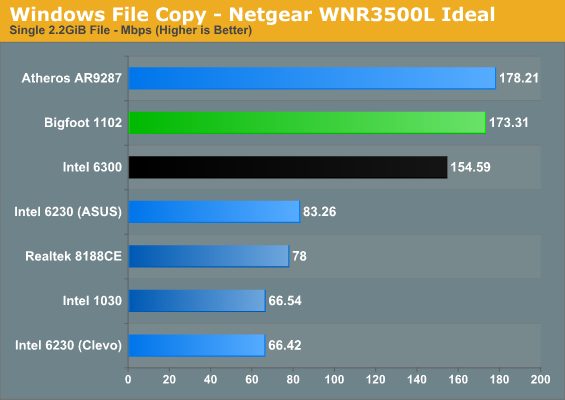
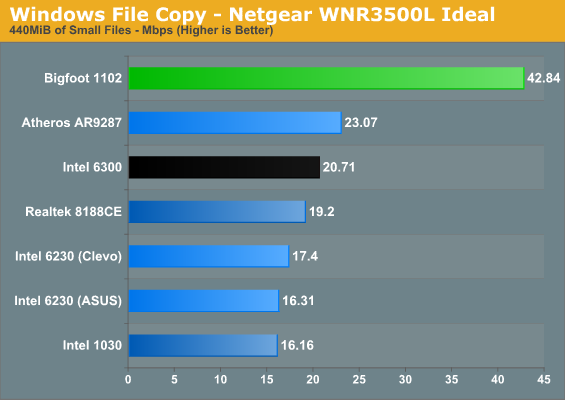
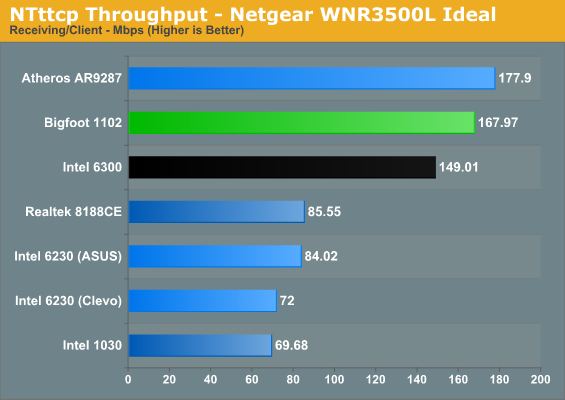
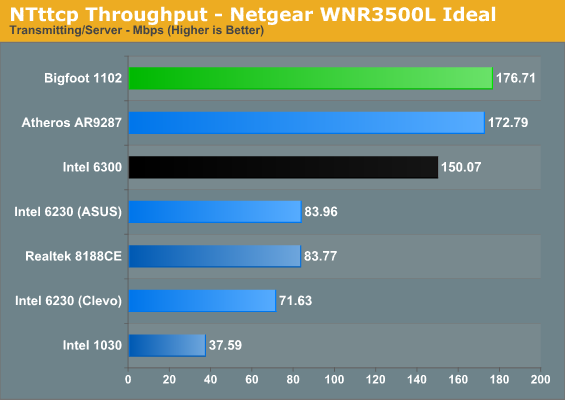

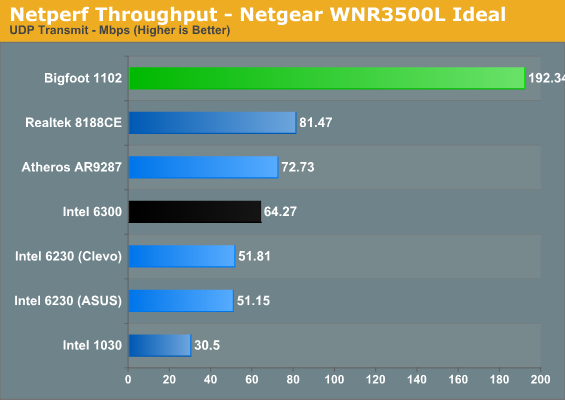
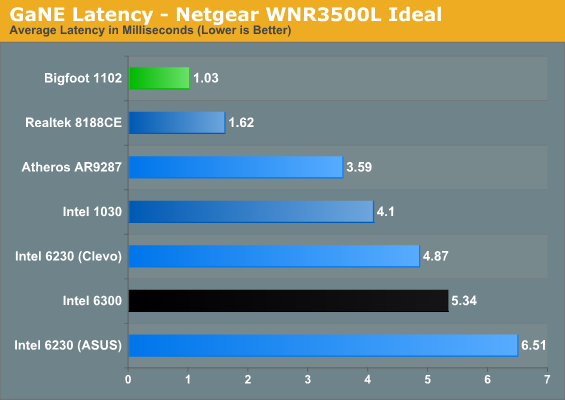
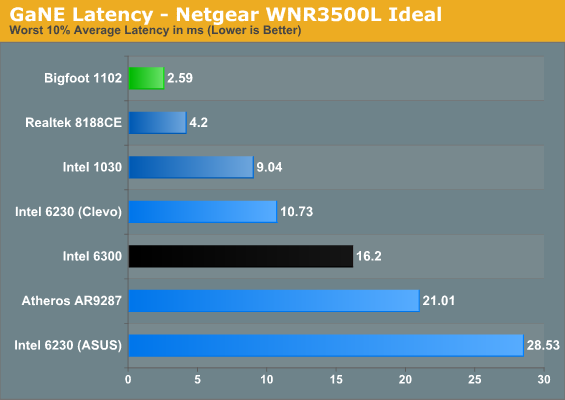
Straight out of the gate, we see a separation develop among the various contenders. At the top of nearly every chart sits the Bigfoot Killer 1102; if it doesn’t outright win, it at least places so close as to be nearly a tie. Keep in mind again that wireless performance is prone to variance, so anything within 5% is close enough that you don’t need to worry much. As noted above, the 6230 would only link up at 144Mbps, which definitely hurts raw throughput; even so, the ASUS K53E appears to work better overall than the Clevo W150HM unit does, showing that not all laptop antennae are equal.
There are two specific tests where the Bigfoot 1102 walks away with the performance crown. The first test is latency, with the 1102 coming very close to wired Ethernet levels of latency (we’ll show those later). The next closest contender for latency is the Realtek solution, and you likely wouldn’t notice the difference. The catch is that there are other areas where the 1102 beats the Realtek quite handily, but we’re getting ahead of ourselves. Outside of the Realtek 8188CE, the Bigfoot 1102’s worst performance is better than the best results from all of the other solutions.
During GaNE testing, virtually every other wireless solution shows occasional spikes of anywhere from 20 to 100+ ms, usually lasting for 5-10 seconds. The Bigfoot 1102 actually showed the same issue, but when we used the Killer Network Manager and set the priority of GaNE to 1 (highest), latency dropped to what we’re reporting above. What’s causing these spikes? It might be Windows searching for other wireless networks; we’re not sure. However, we do have an interesting real-world test that corroborates the GaNE latency results.
If you look at the NTttcp maximum throughput tests, several of the 300Mbps devices are close together. The Atheros AR8132, Bigfoot 1102, and Intel 6300 are all about twice as fast as the other wireless devices. Look at the single large file copy throughput and those same three controllers rise to the top. What’s interesting is what happens when we start copying a lot of smaller files. Suddenly it’s not a question of throughput but is instead how quickly the copy process can transfer each file. Watching the real-time throughput in the networking tab of Windows Task Manager (add the “Bytes Sent/Received per Interval” columns to see this), the lowest throughput on the 1102 is at least double and often triple what the other controllers manage. When you’re copying files and directories, Windows opens a network stream, starts receiving data, and then closes the stream for each file (there might be some other steps, but that description will suffice). If each of those steps ends up taking a few extra milliseconds, multiply that by 9000 and suddenly the process ends up going a lot slower when you have poor latency. In fact, given we’re only transferring 440MiB of data, it appears that the latency/handshaking process takes up around 60 seconds on the Bigfoot 1102 and over 140 seconds on the next closest competitor. Ultimately, GaNE does appear to correlate well with real-world testing.
So do we have a winner in the Bigfoot 1102? If you happen to have a 2x2:2 2.4GHz router (which is probably the most common 802.11n router type) in the same room, the answer is a definite yes. A couple other solutions can come close in terms of pure bandwidth, but the combination of low latency, consistency of connection, and stability offered by the Killer 1102 can’t be beat. Anyone running one of the controllers that only support a single spatial stream (e.g. the Intel 1030 and Realtek 8188CE) will obviously not come close to the same level of performance as the Bigfoot 1102. If you’re after better wireless performance, getting a Killer Wireless-N in your laptop appears to be a good step…but what happens when we move into a different room and obstruct the signal?










52 Comments
View All Comments
JarredWalton - Wednesday, August 10, 2011 - link
I was estimating. I just paced it off, and walking (around corners) it's about 50 feet. In a direct line, it's more like 30 feet. I'll update the distances, though it's all very rough. (I don't have blueprints for the house, but it's about 2300 sqft with an upstairs and downstairs; corner to corner is about 50 feet I'm guessing. I'm revising the distances to be as accurate as possible, but for reference that red vehicle in the driveway is almost 20 feet long if that helps.theqat - Wednesday, August 10, 2011 - link
Any idea when we can expect the Pollux review? I'm trying to make a decision on a laptop fairly soon and I'd love to see what you guys think about it before I do so.Hrel - Wednesday, August 10, 2011 - link
I kept looking for a range test but didn't see it. Having an issue with my Clevo P150HM, had to send it back to cyberpowerpc. Got no wifi signal at all at public places like panera and starbucks. I kind need internet in those places. Huge part of the reason I even have a laptop. It has the Intel 6230 in it cause I need bluetooth.ggathagan - Wednesday, August 10, 2011 - link
Page 7? Entitled "Testing Signal Range"?Focher - Wednesday, August 10, 2011 - link
Once again, Bigfoot's product doesn't really offer anything of extra value to alternative products (personally, I think the UDP test results are wonky and it's unbelievable that a current wifi device would best wired gigabit Ethernet, let alone dominate to the extent that the test showed). You're better off getting a true 3x3:3 card, even if the current performance only matches the 1102. At worst, performance will stay the same. But there's at least a chance that the addition transmit and receive channels will enable improved performance with a firmware update. Sure, if the 1102 is the default card in a particular laptop then fine (although I'd still take the Intel 6300 over it) but I sure wouldn't pay any price premium for it unless it's an upgrade option to replaces some default low end device.neothe0ne - Wednesday, August 10, 2011 - link
yeah, Lenovo and HP are horrible companies. HP is even worse because all their consumer products force you on WiFi Link 1000 (their Bluetooth is offered in a separate chip). Most of the Probooks and Elitebooks and the Envies use Centrino 62xx cards, thankfully... but they're still whitelisted.Peroxyde - Wednesday, August 10, 2011 - link
Hi experts,Sorry for off topic question. Can you please recommend a good wireless router? I have heard of TP-Link 1043ND as being well rated. Is it really better than Linksys or DLink? Thanks in advance
jigglywiggly - Wednesday, August 10, 2011 - link
A LIL LATE FOR THIS ARTICLEI HAVE A CLEVO WITH A 6230
AAAAAAAAAAAAAAAAAAAAAAAAAAAAAAAAAAAAAAA
iamkyle - Thursday, August 11, 2011 - link
The majority of laptops can't even use this card thanks to the legalized monopolization of laptops via whitelists. That crap should be illegal.The_Laughing_Man - Thursday, August 11, 2011 - link
I think Bigfoot should sue those tier one laptop suppliers for anti-competitive practices.Whitelist should be illegal.
I have a brand new HP laptop, I can replace the WiFi card after booting and it works just fine. It is even in the same WiFi family that comes with the laptop and Windows uses the same set of drivers for both cards. But the notebook will not boot with newer dual-band card installed during start-up due to HP whit-list in their BIOS.
On top of that HP encrypts their BIOS such that is is very difficult to hack their BIOS to allow valid WiFi cards, not to mention other things.
HP doesn't even offer an upgrade to a dual-band WiFi card for this very expensive high-end notebook the DV7T, even if I was willing to pay them for it.
And Dell, Asus, Acer, and Sony all do the same thing.
They all need to be sued. And until they remove their whitelists, Bigfoot will be forced to have a very small market to sell their mini-pcie killer-n card to.